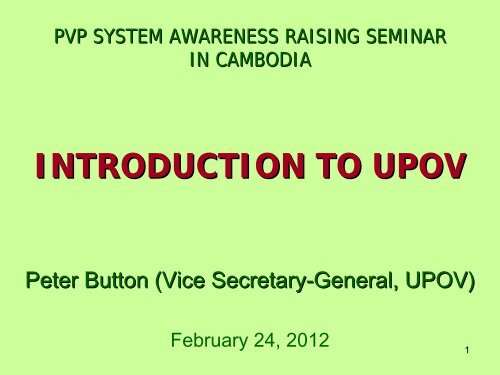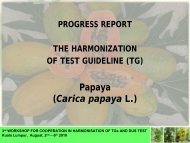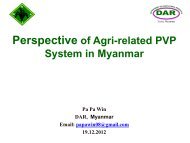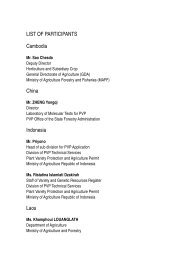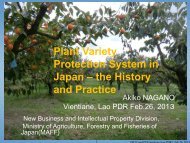Introduction to UPOV convention.pdf - The East Asia Plant Variety ...
Introduction to UPOV convention.pdf - The East Asia Plant Variety ...
Introduction to UPOV convention.pdf - The East Asia Plant Variety ...
You also want an ePaper? Increase the reach of your titles
YUMPU automatically turns print PDFs into web optimized ePapers that Google loves.
PVP SYSTEM AWARENESS RAISING SEMINARIN CAMBODIAINTRODUCTION TO <strong>UPOV</strong>Peter But<strong>to</strong>n (Vice Secretary-General, <strong>UPOV</strong>)February 24, 20121
PREVIEWI. About <strong>UPOV</strong>II Key Provisions of the 1991 Act of the<strong>UPOV</strong> ConventionIII. <strong>UPOV</strong> Website2
PREVIEWI. About <strong>UPOV</strong>II Key Provisions of the 1991 Act of the<strong>UPOV</strong> ConventionIII. <strong>UPOV</strong> Website3
<strong>The</strong> International Union for the …Protection of New Varieties of <strong>Plant</strong>s4
<strong>UPOV</strong> MISSION STATEMENT“To provide and promote an effectivesystem of plant variety protection,with the aim of encouraging thedevelopment of new varieties ofplants, for the benefit of society”5
Members of <strong>UPOV</strong> (green)Initiating States & organizations (brown)6
Development of <strong>Plant</strong> <strong>Variety</strong> ProtectionApplications: All <strong>UPOV</strong>14,00012,00010,0008,000Europe: EU 27Europe: Non-EU 27North America<strong>Asia</strong> / PacificLatin AmericaAfricaNear / Middle <strong>East</strong>6,0004,0002,00001968197019721974197619781980198219841986198819901992199419961998200020022004200620087
• <strong>Plant</strong> breeding is long and expensiveBUT• <strong>Plant</strong> varieties can be easily and quicklyreproducedBreeders need protection <strong>to</strong> recoverinvestment10
PREVIEWI. About <strong>UPOV</strong>IIKey Provisions of the 1991 Act of the<strong>UPOV</strong> ConventionIII. <strong>UPOV</strong> Website11
SOME KEY PROVISIONS OFTHE <strong>UPOV</strong> CONVENTION (1991 Act)(a) Breeders and varieties(b) Genera and species(c) National treatment(d) Conditions of protection(e) Breeder’s right and exceptions12
BREEDER- the person who bred, ordiscovered and developed, a variety- the person who is the employer ofthe aforementioned person or who hascommissioned the latter’s work, wherethe laws of the relevant ContractingParty so provide, or- the successor in title of the first orsecond aforementioned person.14
BREEDER<strong>The</strong> person whobred, or discoveredand developed, avariety15
<strong>The</strong>re are no restrictions on whocan be considered <strong>to</strong> be abreeder under the <strong>UPOV</strong>system: a breeder might be anindividual, a farmer, aresearcher, a public institute, aprivate company etc.16
BREEDER<strong>The</strong> person whobred, or discoveredand developed, avariety17
DISCOVERYOR FINDDEVELOPMENTIS NECESSARY18
BREEDER<strong>The</strong> person whobred, or discoveredand developed, avariety19
SPECIES20
VARIETY21
SOME KEY PROVISIONS OFTHE <strong>UPOV</strong> CONVENTION (1991 Act)(a) Breeders and varieties(b) Genera and species(c) National treatment(d) Conditions of protection(e) Breeder’s right and exceptions22
GENERA AND SPECIESTO BE PROTECTED(1991 ACT: New members of the Union)• At least 15 plant genera or species onbecoming bound by the <strong>UPOV</strong> Convention• ALL plant genera and species within 10years23
NON-RESIDENT PBR APPLICATIONS(Selected Countries in Latin America)300250Number of Non-Resident PBR Applications200150100EcuadorColombia50ArgentinaMexicoChileBrazil0-4 -3 -2 -1 0 1 2 3 4Years after <strong>UPOV</strong> MembershipArgentina, Chile, Colombia, Ecuador and Mexico provide protection forall genera and species of the plant kingdom.24
BRAZIL: Applications filed by Non-Residents1401201008060Number of Non-ResidentapplicationsNumber of species for whichprotection available40200-2 -1 0 1 2 3 4 5 6 7 8 9 10Years after <strong>UPOV</strong> membership25
MEETING the CHALLENGE• Cooperation between Authorities can involve:– purchase of DUS Test Reports from otherAuthorities– bilateral arrangements <strong>to</strong> remove the need forduplication of DUS Tests– centralized DUS testing at regional or globallevel• Cooperation with Breeders• Support from <strong>UPOV</strong>– other members of the Union– <strong>UPOV</strong> Office26
COOPERATIONNumber of genera/speciesfor which varietiesprotected by members ofthe Union: > 3,000Practical DUSexperience offeredfor >2,600 generaand species(>10,000 titles granted/annum)Agreements forcooperation betweenmembers of the Union:> 1,40027
SOME KEY PROVISIONS OFTHE <strong>UPOV</strong> CONVENTION (1991 Act)(a) Breeders and varieties(b) Genera and species(c) National treatment(d) Conditions of protection(e) Breeder’s right and exceptions28
NATIONAL TREATMENT• National treatment, within the terri<strong>to</strong>ry of amember of the Union, for nationals andresidents of any other members of the Union29
SOME KEY PROVISIONS OFTHE <strong>UPOV</strong> CONVENTION (1991 Act)(a) Breeders and varieties(b) Genera and species(c) National treatment(d) Conditions of protection(e) Breeder’s right and exceptions30
Criteria <strong>to</strong> be satisfied• NOVELTYCONDITIONS FOR GRANTING ABREEDER’S RIGHT…31
CONDITIONS FOR GRANTING ABREEDER’S RIGHT• Novelty : No sale or disposal within• 1 year - own terri<strong>to</strong>ry• 4 years - other terri<strong>to</strong>ry (6 years - trees/vine)• Exception for varieties of recent creation(new members / extension of protection)32
CONDITIONS FOR GRANTING ABREEDER’S RIGHTCriteria <strong>to</strong> be satisfied• NOVELTY• DISTINCTNESS• UNIFORMITY• STABILITY“DUS”…33
DISTINCTNESSApple: Fruit colorApple: Flower bud color34
UNIFORMITYA uniform varietyA variety lacking uniformity35
STABILITYStable variety<strong>The</strong> relevant characteristics of the variety do not change through the generations.Original material Generation 1 Generation 2 Generation N<strong>Variety</strong> not stable / Variété non stable<strong>The</strong> relevant characteristics of the variety change through the generations. <strong>The</strong> plant grouping no longerretains the expression of the relevant characteristics of the original variety.Original material Generation 1 Generation 2 Generation N36
Nature of the DUS Examination<strong>The</strong> “DUS Test” (field trial)37
CONDITIONS FOR GRANTING ABREEDER’S RIGHT… Other requirements• VARIETY DENOMINATION• FORMALITIES• PAYMENT OF FEESNO OTHER CONDITIONS!38
SOME KEY PROVISIONS OFTHE <strong>UPOV</strong> CONVENTION (1991 Act)(a) Breeders and varieties(b) Genera and species(c) National treatment(d) Conditions of protection(e) Breeder’s right andexceptions39
MINIMUM DURATION OF PROTECTIONTREES and VINES25 yearsOTHER PLANTS20 yearsTo be counted from the date of grant40
Authorization of breeder required for:• Production or reproduction (multiplication)• Conditioning for the purpose of propagation• Offering for sale• Selling or marketing• Exporting• Importing• S<strong>to</strong>cking for any of the above purposes…. for any protected variety41
MATERIAL COVERED• All propagating materialSEEDS42
MATERIAL COVERED• All propagating material• Harvested materialif obtained through unauthorized use ofpropagating material unless, reasonableopportunity for breeder <strong>to</strong> exercise his right• Certain products (optional)43
VARIETIES COVEREDVARIETIES:• not clearly distinguishable from theprotected variety• whose production requires therepeated use of the protectedvarietye.g. hybrids• which are essentially derived from theprotected variety …44
VARIETIES COVEREDPURPOSE:ESSENTIAL DERIVATION<strong>to</strong> ensure sustainable plant breedingdevelopment by:– providing effective protection for thebreeder and– encouraging cooperation between breedersand developers of new technologies suchas genetic modification45
VARIETIES COVEREDEssentially Derived VarietiesMay be obtained for example by:• selection of a natural or induced mutant• selection of a somaclonal variant• selection of a variant individual from plantsof the initial variety• back-crossingcrossing• transformation by genetic engineering46
VARIETIES COVERED...a variety shall be deemed <strong>to</strong> be essentially derivedfrom another variety (“the initial variety”) when(i) it is predominantly derived from the initialvariety, or from a variety that is itself predominantlyderived from the initial variety, while retaining theexpression of the essential characteristics that resultfrom the genotype or combination of genotypes of theinitial variety,(ii) it is clearly distinguishable from the initialvariety and(iii) except for the differences which result from theact of derivation, it conforms <strong>to</strong> the initial variety inthe expression of the essential characteristics thatresult from the genotype or combination of genotypesof the initial variety.47
VARIETIES COVEREDCan EDVs be protected ?YESCan EDVs be commerciallyexploited?AUTHORIZATIONNEEDEDrequires the authorization of thePBR holder of the initial variety48
VARIETIES COVEREDInitial <strong>Variety</strong> ‘A’(PROTECTED)bred and protected by Breeder 1Essentially Derived <strong>Variety</strong> ‘B’bred and protected by Breeder 2- predominantly derived from ‘A’- retains expression of essential characteristics of ‘A’- clearly distinguishable from ‘A’- conforms <strong>to</strong> ‘A’ in essential characteristics(except for differences from act of derivation)Commercialization:authorization ofBreeders 1 and 2 requiredEssentially Derived <strong>Variety</strong> ‘C’bred and protected by Breeder 3- predominantly derived from ‘A’ or ‘B’- retains expression of essential characteristics of ‘A’- clearly distinguishable from ‘A’- conforms <strong>to</strong> ‘A’ in essential characteristics(except for differences from act of derivation)Commercialization:authorization ofBreeders 1 and 3 required(authorization of Breeder 2not required)49
VARIETIES COVEREDInitial <strong>Variety</strong> ‘A’(NOT PROTECTED)bred and protected by Breeder 1Essentially Derived <strong>Variety</strong> ‘B’bred and protected by Breeder 2- predominantly derived from ‘A’- retains expression of essential characteristics of ‘A’- clearly distinguishable from ‘A’- conforms <strong>to</strong> ‘A’ in essential characteristics(except for differences from act of derivation)Commercialization:authorization ofBreeder 2 required(authorization of Breeder 1not required)Essentially Derived <strong>Variety</strong> ‘C’bred and protected by Breeder 3- predominantly derived from ‘A’ or ‘B’- retains expression of essential characteristics of ‘A’- clearly distinguishable from ‘A’- conforms <strong>to</strong> ‘A’ in essential characteristics(except for differences from act of derivation)Commercialization:authorization ofBreeder 3 required(authorization of Breeder1and 2 not required)50
EXCEPTIONS TO THEBREEDER’S RIGHT51
EXCEPTIONS TO THE BREEDER’S RIGHTCompulsoryActs done:• privately and for non-commercialpurposes• for experimental purposes• breeding other varieties (breeder’sexemption”)OptionalFarm-saved seed52
EXCEPTIONS TO THE BREEDER’S RIGHTCompulsoryActs done:• privately and for non-commercialpurposes• for experimental purposes• breeding other varieties(“breeder’s s exemption”)53
THE BREEDER’S EXEMPTION: ExampleProtected<strong>Variety</strong> A<strong>Variety</strong> BBreeder 1Breeder 2Breeder 3Authorizationof Breeder 1NOTrequired<strong>Variety</strong> CAuthorizationof Breeder 2NOTrequiredAuthorizationof Breeder 1NOTrequired*Authorizationof Breeder 2NOTrequiredCommercialization* Except for:(i) varieties which are essentially derived from the protected variety, where the protected variety is not itself an essentially derived variety,(ii) varieties which are not clearly distinguishable in accordance with Article 7 from the protected variety and(iii) varieties whose production requires the repeated use of the protected variety.54
ADVANTAGES OF THEBREEDER’S EXEMPTION• Germplasm sources remain accessible <strong>to</strong>the community of breeders• Genetic basis for plant improvement isbroadened and is actively conserved• <strong>Variety</strong> improvement is enhanced• Opportunity for all breeders <strong>to</strong> share inbenefits of breeding activities55
EXCEPTIONS TO THE BREEDER’S RIGHTCompulsoryActs done:• privately and for non-commercial purposes• for experimental purposes• breeding other varieties(breeder’s exemption”)56
EXCEPTIONS TO THE BREEDER’S RIGHT• Compulsory(i) Acts done privately and for non-commercial purposes• amateur gardenerActs Possibly falling within the scope of the exception57
EXCEPTIONS TO THE BREEDER’S RIGHT• Compulsory(i) Acts done privately and for non-commercial purposes• propagation of a variety by a farmer exclusively for the production ofa food crop <strong>to</strong> be consumed entirely by that farmer and thedependents of the farmer living on that holdingtherefore“subsistence farming” where these constitute acts done privatelyand for non-commercial purposes, may be considered by a <strong>UPOV</strong>member <strong>to</strong> be excluded from the scope of the breeder’s rightActs Possibly falling within the scope of the exception58
EXCEPTIONS TO THE BREEDER’S RIGHTCompulsoryActs done:• privately and for non-commercialpurposes• for experimental purposes• breeding other varieties (breeder’sexemption”)OptionalFarm-saved seed59
EXCEPTIONS TO THE BREEDER’S RIGHTA Contracting Party may restrict breeder’srights in order <strong>to</strong> permit farmers <strong>to</strong> use:• for propagating purposes on their own holdingsthe product of the harvest• obtained on their own holdingsfrom the protected variety• within reasonable limits• subject <strong>to</strong> safeguarding legitimate interests ofthe breeder[Article 15(2) and Recommendation of theDiplomatic Conference]60
EXCEPTIONS TO THE BREEDER’S RIGHTProduct of the harvest:Product of the harvest can be used for propagating purposessmall grain cereals:harvested product may = propagating materialFruit, ornamentals and vegetables:harvested product may ≠ propagating material61
EXCEPTIONS TO THE BREEDER’S RIGHTReasonable limits and safeguarding thelegitimate interest of the breederPossible fac<strong>to</strong>rs:- Type of variety- Size of holding/crop area/crop value- Proportion/amount of harvested materialReview over time- Remuneration <strong>to</strong> the breeder62
HOW TO BECOME AMEMBER OF <strong>UPOV</strong>State/Intergovernmental Organizationmust:• Have a law which conforms <strong>to</strong> <strong>UPOV</strong>Convention• Ask advice of the Council of <strong>UPOV</strong>• If advice positiveadvice positive: deposit instrumen<strong>to</strong>f accession63
PREVIEWI. About <strong>UPOV</strong>II Key Provisions of the 1991 Act of the<strong>UPOV</strong> ConventionIII. <strong>UPOV</strong> Website64
http://www.upov.int65
THANK YOU66


